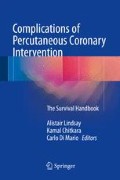Abstract
Use of radial artery access for percutaneous coronary intervention (PCI) has increased greatly in recent years although uptake varies widely throughout the world. While an increasing body of evidence supports use of the radial artery as a safe access route for PCI, a ‘radial learning curve’ remains an obstacle to uptake, especially for established femoral operators seeking to increase the proportion of radial procedures. Untreated radial artery spasm is not only painful, but may result in patient harm if alternate arterial access (e.g. the femoral artery) is unavailable. An understanding of simple procedural modifications can be the difference between procedural success and failure.
Access this chapter
Tax calculation will be finalised at checkout
Purchases are for personal use only
References
Hamon M, Pristipino C, Di Mario C, Nolan J, Ludwig J, Tubaro M, et al. Consensus document on the radial approach in percutaneous cardiovascular interventions: position paper by the European Association of Percutaneous Cardiovascular Interventions and working groups on acute cardiac care and thrombosis of the European Society of Cardiology. EuroIntervention. 2013;8(11):1242–51.
Yoo BS, Yoon J, Ko JY, Kim JY, Lee SH, Hwang SO, Choe KH. Anatomical consideration of the radial artery for transradial procedures: arterial diameter, branching anomaly and vessel tortuosity. Int J Cardiol. 2005;101:421–7.
Saito S, Ikei H, Hosokawa G, Tanaka S. Influence of the ratio between radial artery inner diameter and sheath outer diameter on radial artery flow after transradial coronary intervention. Catheter Cardiovasc Interv. 1999;46:173–8.
Barbeau GR, Arsenault F, Dugas L. Evaluation of the unipalmar arterial arches with pulse oximetry and plethysmography: comparison with the modified Allen’s test in 1010 patients. Am Heart J. 2004;147:489–93.
Kotowycz MA, Dzavik V. Radial artery patency after transradial catheterization. Circ Cardiovasc Interv. 2012;5:127–33.
Jeserich M, Just H. Effect of nitrates on arterial blood vessels exemplified by the radial artery. Z Kardiol. 1998;87(2):77–83.
Kiemeneij F, Vajifdar BU, Eccleshall SC, et al. Evaluation of a spasmolytic cocktail to prevent radial artery spasm during coronary procedures. Catheter Cardiovasc Interv. 2003;58:281–4.
Spaulding C, Lefevre T, Funck F, Thébault B, Chauveau M, Ben Hamda K, et al. Left radial approach for coronary angiography: results of a prospective study. Cathet Cardiovasc Diagn. 1996;39(4):365–70.
Bertrand OE, Rao SV, Pancholy S, Jolly SS, Rodés-Cabau J, Larose E, et al. Transradial approach for coronary angiography and interventions: results of the first international transradial practice survey. J Am Coll Cardiol Cardiovasc Interv. 2010;3(10):1022–31.
Rathore S, Stables RH, Pauriah M. Impact of length and hydrophilic coating of the introducer sheath on radial artery spasm during transradial coronary intervention: a randomized study. J Am Coll Cardiol Cardiovasc Interv. 2010;3(5):475–83.
Kozak M, Adams DR, Ioffreda MD. Sterile inflammation associated with transradial catheterization and hydrophilic sheaths. Catheter Cardiovasc Interv. 2003;59:207–13.
Shah A, Kintur S. Balloon assisted tracking of a guide catheter through radial artery loop and spasm. Cath Lab Digest. 2013;21(2):24–5.
Lo TS, Nolan J, Fountzopouos E, Behan M, Butler R, Hetherington SL, et al. Radial artery anomaly and its influence on transradial coronary procedure outcome. Heart. 2009;95:410–5.
Roberts DH, Wiper A. Vascular access: femoral versus radial. In: Redwood S, Curzen N, Thomas M, editors. Oxford textbook of interventional cardiology. Oxford: Oxford University Press; 2010.
Author information
Authors and Affiliations
Corresponding author
Editor information
Editors and Affiliations
Rights and permissions
Copyright information
© 2016 Springer-Verlag London
About this chapter
Cite this chapter
Kelly, D.J. (2016). Preventing and Treating Radial Spasm. In: Lindsay, A., Chitkara, K., Di Mario, C. (eds) Complications of Percutaneous Coronary Intervention. Springer, London. https://doi.org/10.1007/978-1-4471-4959-0_4
Download citation
DOI: https://doi.org/10.1007/978-1-4471-4959-0_4
Publisher Name: Springer, London
Print ISBN: 978-1-4471-4958-3
Online ISBN: 978-1-4471-4959-0
eBook Packages: MedicineMedicine (R0)

